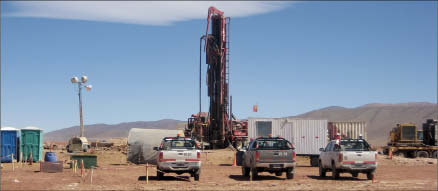All systems are go for Lithium Americas (LAC-T) as it drives to get the world’s next major lithium mine into production.
The company reached a milestone when it launched a pilot plant for its flagship Cauchari-Olaroz lithium project in northwestern Argentina.
The plant is in Lakefield, Ont., but once the pilot period is over it will be shipped to Argentina th America so that it can process lithium-bearing material from Cauchari-Olaroz.
News of the pilot plant’s success had the company’s shares up 20%, or 28¢, to $1.70, making it the highest gainer amongst miners on the TSX on Nov. 8 – the day the news was released.
The company says the pilot plant is designed to produce 30 kg of 99.5% purity lithium carbonate per day. That purity level is considered battery grade.
As the carbonate comes out of the plant in Lakefield, it will be shipped to Lithium Americas’ two key partners, Mitsubishi (MTU-N) and Magna International (MG-T), and other potential customers, to ensure it meets their respective specifications.
After the test period is over and the plant is reassembled in Argentina, it will be fed concentrated lithium brine from industrial-scale evaporation ponds on the two salt lakes that make up Cauchari-Olaroz.
The company says pilot production will carry on throughout 2012.
“While other companies have been able to produce lithium carbonate at lab scale, production at pilot-plant scale is more complex and requires having evaporation ponds on-site in order to produce the necessary volume of lithium concentrate to feed the pilot plant,” Waldo Perez, Lithium Americas’ president and chief executive, said in a statement.
There was also good news on the by-product front, after boron was extracted from the brine using a proprietary solvent extraction technology and potash flotation studies at the Saskatchewan Research Council produced 95% purity potassium chloride.
Cauchari-Olaroz is made up of two adjacent salt lakes of the same name. The project sits in the heart of the Puna plateau in Jujuy province, which is near the Chilean border. The plateau holds 80% of the world’s lithium brine reserves.
Sociedad Quimica y Minera (SQM-N) and Chemetall operate the world’s largest lithium mine at Salar de Atacama in Chile, 200 km west of Cauchari and Olaroz. Some 200 km south of the project lies FMC‘s (FMC-N) Salar del Hombre Muerto, which is considered the second-largest lithium mine.
Cauchari and Olaroz have the world’s third-largest lithium brine resource.
A preliminary economic assessment on the project in April estimates operating costs of US$1,434 per tonne of lithium carbonate, not including potash and boron by-product credits. Those costs could make Lithium Americas the world’s lowest-cost lithium producer and help generate a net present value of US$983 million using an 8% discount rate.
The company has offtake arrangements with Mitsubishi and Magna International. The two shareholders have the option to buy up to 37.5% of the junior’s lithium production.
Lithium Americas is pushing ahead on a definitive feasibility study for the project, which is fully funded and expected to be finished in the first quarter of next year.


Be the first to comment on "Lithium Americas leads the lithium race"